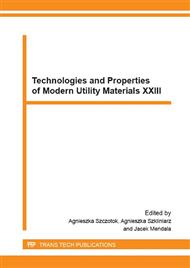p.171
p.177
p.183
p.189
p.193
p.197
p.201
p.207
p.213
Mechanical Performance of Polymer-Matrix Laminate Reinforced with 3D Fabric during Three-Point Impact Bending
Abstract:
The paper presents the analysis of course and the results of impact 3-point bending tests conducted with use of instrumented Charpy hammer (CEAST RESIL 50 hammer + MC101 registrator + CALKA J computer program) on GFRP laminate specimens cut of the panels manufactured by RTM method on base of classic plain-woven fabric preform and 3D fabric. The specimens of the 3D laminate were cut alternatively along (W direction) and transverse (P direction) to the translaminar interweave strands. It was found that maximum force obtained in the tests is comparable for both the classic and the 3D laminates. Deformability of the 3D (W) specimen is by about 20% higher than those of the classic laminate, whereas it is higher by even 75% for 3D (P). The trend of deformability observed for the tested laminates differs from known trends characteristic for static conditions what confirms different material response mechanisms at low and higher load rate. Failure energy in the classic and in the 3D (W) specimen is on comparable level. However, 3D (P) specimen showed slightly lower summary failure energy than the classic one and almost twice a high failure initiation energy (first effects of failure occur before maksimum load is gained).
Info:
Periodical:
Pages:
193-196
Citation:
Online since:
February 2016
Authors:
Keywords:
Price:
Сopyright:
© 2016 Trans Tech Publications Ltd. All Rights Reserved
Share:
Citation:


